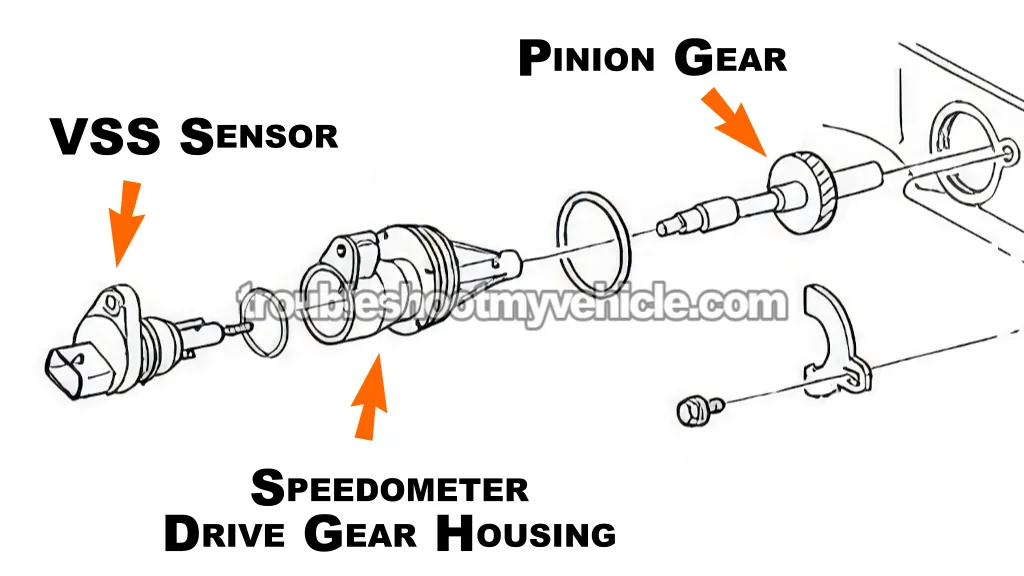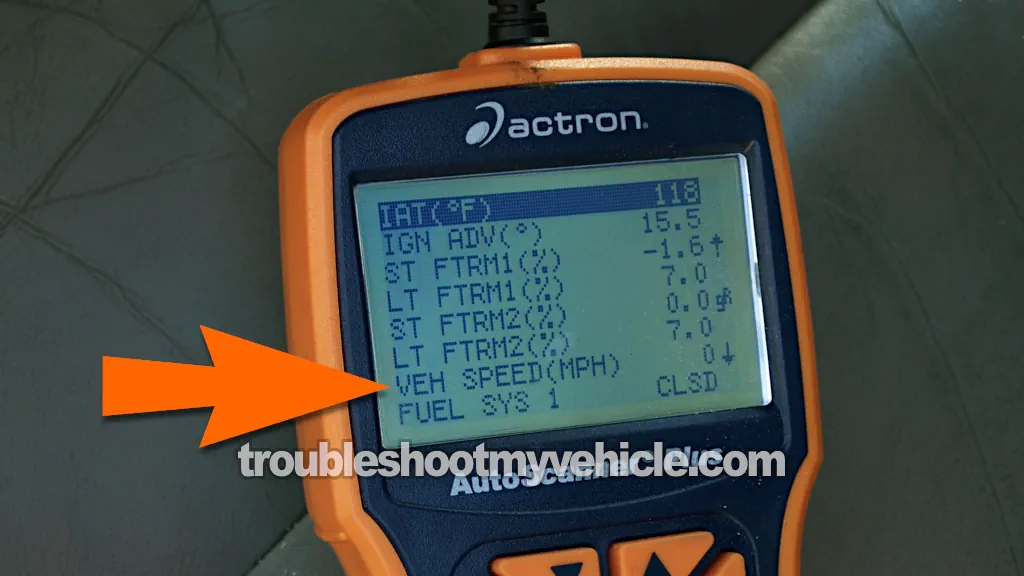
In this tutorial, I'm gonna show you how to diagnose the vehicle speed sensor (VSS) that's triggering an OBD-I Code 15 —which gets set when the PCM isn't receiving any speed input from the sensor.
We'll use a multimeter to test the VSS sensor —checking if it's generating a signal and confirming it's getting both power and Ground. I'll walk you through the process with clear, step-by-step instructions —no scan tool needed.
Contents of this tutorial:
- What Does The Vehicle Speed Sensor Do?
- Symptoms Of A Bad VSS Sensor.
- Most Common Causes Of Code 15 (VSS Signal Error).
- Should I Just Replace The VSS Without Testing First?
- Where To Buy The VSS Sensor And Save.
- TEST 1: Verifying The Vehicle Speed Signal With A Scan Tool.
- TEST 2: Checking For The VSS Signal At The Sensor Connector.
- TEST 3: Making Sure The VSS Sensor Is Getting Power.
- TEST 4: Making Sure The VSS Sensor Is Getting Ground.
- TEST 5: Inspecting The Plastic Speedometer Pinion Gear.
- A More Controlled Method for Spinning the Wheels During the VSS Signal Test.
- PCM Receives VSS Signal —But the Speedometer Stays At Zero.
- Updated VSS Sensor Connector And Why Soldering Is Critical.
- More 5.2L, 5.9L V8 Dodge Ram Pickup Tutorials.
APPLIES TO: This tutorial applies to the following vehicles with a 3-wire VSS sensor on the transmission tail housing:
- 1993:
- Dodge Ram 150 Pickup 5.2L V8: 1993.
- Dodge Ram 250 Pickup 5.2L V8: 1993.
- Dodge Ram 150 Pickup 5.9L V8: 1993.
- Dodge Ram 250 Pickup 5.9L V8: 1993.
- Dodge Ram 350 Pickup 5.9L V8: 1993.
- 1994-1995:
- Dodge Ram 1500 Pickup 5.2L V8: 1994, 1995.
- Dodge Ram 2500 Pickup 5.2L V8: 1994, 1995.
- Dodge Ram 1500 Pickup 5.9L V8: 1994, 1995.
- Dodge Ram 2500 Pickup 5.9L V8: 1994, 1995.
- Dodge Ram 3500 Pickup 5.9L V8: 1994, 1995.
VSS SENSOR DIAGNOSTIC TUTORIALS:
- How To Index The VSS And Speedometer Gear Housing (1993-1997 5.2L, 5.9L V8 Dodge Ram Pickup).
- VSS Sensor Tests -P0500 DTC (1996-1997 5.2L, 5.9L V8 Dodge Ram Pickup).
What Does The Vehicle Speed Sensor Do?
Put simply, the vehicle speed sensor (VSS) tells the PCM how fast your pickup is moving down the road.
It's a Hall-effect sensor, which means it needs an 8-Volt power supply and a ground connection — both provided by the PCM — to function properly and send a signal back.
Here's what the sensor is actually doing, in a nutshell:
- As the rear wheels rotate, they spin the driveshaft, which turns the speedometer pinion gear — this gear is what drives the VSS sensor.
- As the gear spins, the VSS sensor rapidly switches the 5-Volt signal ON and OFF, generating a square wave signal that the PCM can read.
These ON/OFF 5-Volt pulses come faster as the wheels spin faster.
This pulsing signal gives the PCM the info it needs to calculate vehicle speed, which it uses to manage things like idle control, cruise control, and fuel delivery.
Symptoms Of A Bad VSS Sensor
When the vehicle speed sensor (VSS) fails or its signal can't reach the PCM and speedometer, your Dodge Ram will usually give you a few clear warning signs:
- Check Engine Light (CEL): If the PCM can't detect a valid speed input, it'll store a Code 15 and turn on the check engine light.
- Speedometer behaving oddly or not working at all: You might see the needle freeze, jump around randomly, or drop straight to zero even while driving.
Most Common Causes Of Code 15 (VSS Signal Error)

When your PCM stores a Code 15, it's telling you it's not seeing a valid signal from the vehicle speed sensor (VSS).
This loss of signal can come from a number of problems —from a faulty sensor to wiring faults, or even internal PCM failure. Here are the top culprits:
- Defective VSS sensor: Over time, the sensor itself can fail electrically or mechanically, preventing it from producing a usable pulse signal.
- Cut, corroded, or broken VSS signal wire: The white with orange stripe (WHT/ORG) wire might be damaged or open.
- This wire feeds the signal to pin 47 of the 60 pin PCM connector and also connects to the speedometer.
- Loss of 8V power supply: The orange wire (ORG) provides 8 Volts from pin 7 of the PCM 60 pin connector. If this wire is open or shorted, the sensor can't operate.
- Open Ground circuit: The sensor's Ground is handled by the black with light blue stripe (BLK/LT BLU) wire, which goes to pin 4 of the PCM 60 pin connector. Without a solid Ground, the sensor won't function.
- Worn or broken plastic pinion gear: A stripped or damaged gear inside the transmission means the VSS has nothing to read from —no rotation, no signal.
- PCM failure (rare): If every other component checks out, the fault may lie inside the PCM, which might not be interpreting the signal even if it's getting it.
- Improperly installed VSS sensor: If the sensor isn't clocked correctly during installation, its drive gear won't engage properly —the PCM and speedometer still receive a speed signal, it's just not the correct vehicle speed.
Should I Just Replace The VSS Without Testing First?
When Code 15 pops up, a lot of folks immediately assume the vehicle speed sensor is toast —and go straight to swapping it out. Makes sense, right? The code points to the sensor, so why not?
Honestly, in many cases, that quick fix does the trick. Replacing the sensor often clears the code and brings the speedometer back to life.
So if you're leaning toward just replacing it —go for it. No one's gonna give you grief for taking the shortcut (LOL).
Just make sure you install it correctly. Here's a guide to help you get the sensor properly aligned with the transmission:
But —if you've already put in a new sensor and you're still seeing the code, or the speedometer's still dead, or maybe you just want to test before buying parts— this tutorial walks you through exactly how to test the VSS step by step.
Where To Buy The VSS Sensor And Save
Disclosure: As an Amazon Associate, I earn from qualifying purchases. If my tutorials help you, using these links is an easy way to support the site at no extra cost to you. Thank you!
TEST 1: Verifying The Vehicle Speed Signal With A Scan Tool

If you have an OBD-I scan tool with live-data functionality, we'll use it to confirm whether the PCM is actually receiving a signal from the vehicle speed sensor (VSS).
If you don't have one, skip this section and jump to TEST 2: Checking For The VSS Signal At The Sensor Connector.
Using the scan tool, we'll monitor the VEHICLE SPEED PID (Parameter ID) while taking the truck for a short drive.
If the VSS is working correctly, you'll see the speed update in real time on the screen.
However, if the display stays at zero throughout the drive, the PCM isn't seeing any speed pulses. In that case, we'll move on to TEST 2 to test the sensor directly at its connector.
NOTE: Have a helper do the driving while you watch the scan-tool display.
Time to dive in:
- 1
Connect your scan tool and turn the key to the ON position.
- 2
Navigate to the live data or datastream section.
- 3
Scroll through the available data and locate the VEHICLE SPEED (MPH or km/h) PID.
- 4
Start the engine and begin a short road test.
- 5
Have a helper watch the scan tool as you drive.
- 6
The VEHICLE SPEED PID should show the MPH in real time as the vehicle moves.
Let's figure out what your test result is telling us:
CASE 1: The scan tool did not show any vehicle speed while driving. This confirms the PCM is not receiving a signal from the vehicle speed sensor. Code 15 is valid.
Our next step is to check for the VSS signal output directly at the VSS sensor connector. Go to: TEST 2: Checking For The VSS Signal At The Sensor Connector.
CASE 2: The scan tool displayed vehicle speed normally. This means the vehicle speed sensor is currently functioning and sending data to the PCM.
Code 15 may be intermittent. Clear the code, continue driving, and retest if the code returns.
TEST 2: Checking For The VSS Signal At The Sensor Connector

The vehicle speed sensor (VSS) produces a pulsed 5-Volt signal that switches between ON and OFF as the rear wheels spin. In a nutshell:
- ON: The signal wire reads 5 Volts.
- OFF: Voltage drops to 0 Volts.
In this test, we're gonna verify that pulsed signal right at the sensor by checking for voltage changes on the white with orange stripe (WHT/ORG) wire —this is the VSS output wire that sends speed info to the PCM.
To perform the test safely, you'll need to raise the rear of the truck, set it on jack stands, and let the engine idle while it's in Drive. That'll spin the driveshaft and rear wheels.
The one important thing to keep in mind here, is that you don't want the rear wheels spinning too fast, otherwise, you won't be able to see the ON/OFF voltage pulse from the VSS sensor.
IMPORTANT: If the wheels rotate too fast, your multimeter might just show a solid 5V —masking the pulse signal. That's why it's critical to have a helper gently press the brake pedal to keep the rotation slow and steady. For a more precise method, check out:
NOTE: Don't unplug the sensor —it needs to remain connected to its 3-wire connector. You'll use a wire-piercing probe to tap into the signal line without disconnecting anything. Need one? Learn more here: Wire Piercing Probe Tool.
SAFETY WARNING: This test involves working underneath the vehicle while parts of the drivetrain are in motion. Be careful! Here are some important safety guidelines to keep in mind:
- Always wear safety glasses —dirt, rust, or debris can fall directly into your eyes while you're under the truck.
- Set the vehicle on heavy-duty jack stands placed on a flat, stable surface. Never trust a hydraulic jack alone to hold the vehicle.
- Chock the front wheels to keep the truck from rolling forward unexpectedly.
- Keep hands, tools, and loose clothing far away from moving components like the driveshaft and wheels.
- Let the engine idle only —absolutely no revving during this test.
- Make sure a helper stays in the driver's seat the entire time, with their foot ready on the brake pedal.
If you don't have a multimeter or need to upgrade yours? This is the one I use and recommend: Tekpower TP8268 AC/DC Auto/Manual Range Digital Multimeter (at: amazon.com).
OK, let's get started:
- 1
Lift the rear of the truck and set it on heavy-duty jack stands.
- 2
Chock the front wheels and have a helper in the driver's seat.
Your helper should be ready to apply the brakes the moment anything unexpected happens. - 3
Locate the white with orange stripe (WHT/ORG) signal wire at the VSS connector.
- 4
Set your multimeter to the DC Volts mode.
- 5
Attach the red multimeter lead to the WHT/ORG wire using either a wire-piercing probe or a back-probing method on the connector.
- 6
Connect the black multimeter lead to bare metal on the chassis or engine block.
NOTE: Be sure the metal contact point is free of paint, rust, or grease to ensure a solid Ground. - 7
Start the engine and shift into Drive while your helper holds the brake to prevent the wheels from turning initially.
- 8
Let your helper gradually release the brake pedal so the wheels begin turning slowly at idle while you keep your eyes on the multimeter.
NOTE: No stepping on the accelerator —you need a slow rotation speed.
If the wheels start spinning too fast, have your helper lightly press the brake to slow them down just enough to catch the ON/OFF voltage pulses. - 9
You should see a pulsing DC signal, quickly switching between 0V and 5V.
Here's how to interpret your test results:
CASE 1: No ON/OFF pulses from the signal wire. This tells us the vehicle speed sensor isn't outputting any signal.
The next step is to check whether the sensor is actually receiving the voltage it needs to work. Head over to: TEST 3: Making Sure The VSS Sensor Is Getting Power.
CASE 2: Your multimeter shows the ON/OFF pulses. That confirms the sensor is alive and generating the correct signal as the wheels turn.
This result also tells us the PCM is successfully providing both 5 Volts and Ground to the VSS sensor.
If Code 15 keeps coming back, there's a good chance the PCM isn't reading that signal internally. An internal fault in the PCM is rare —but not unheard of.



